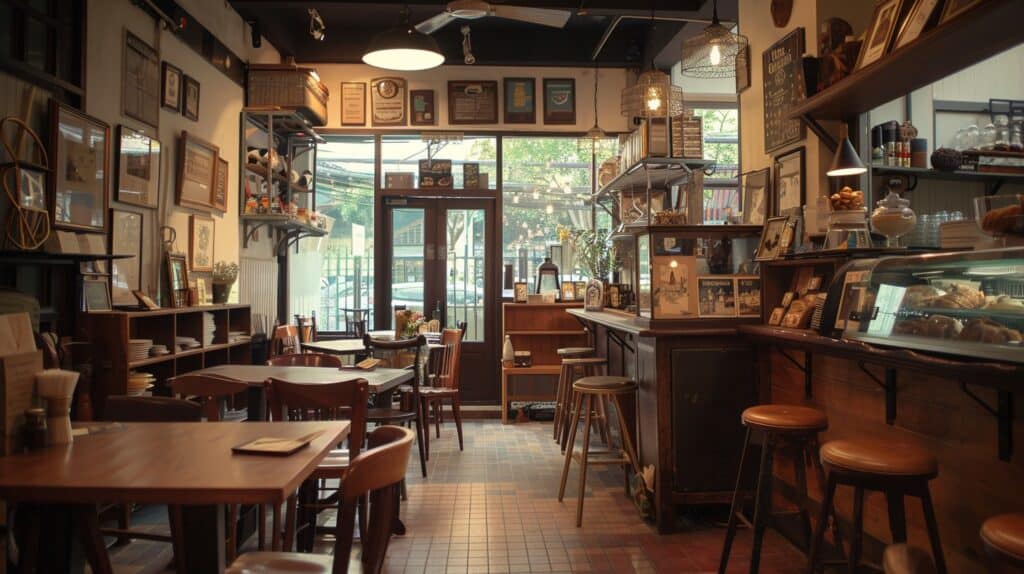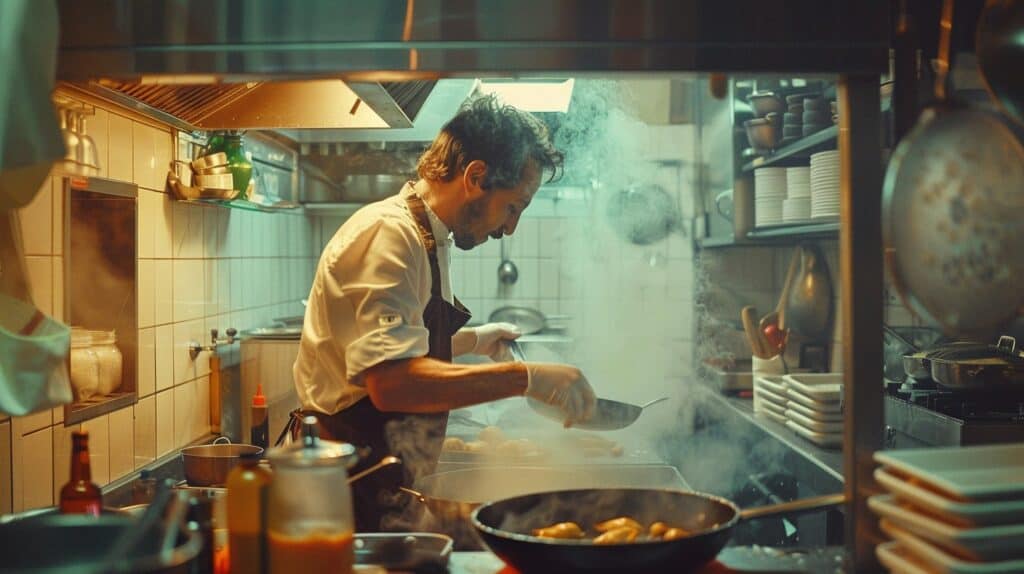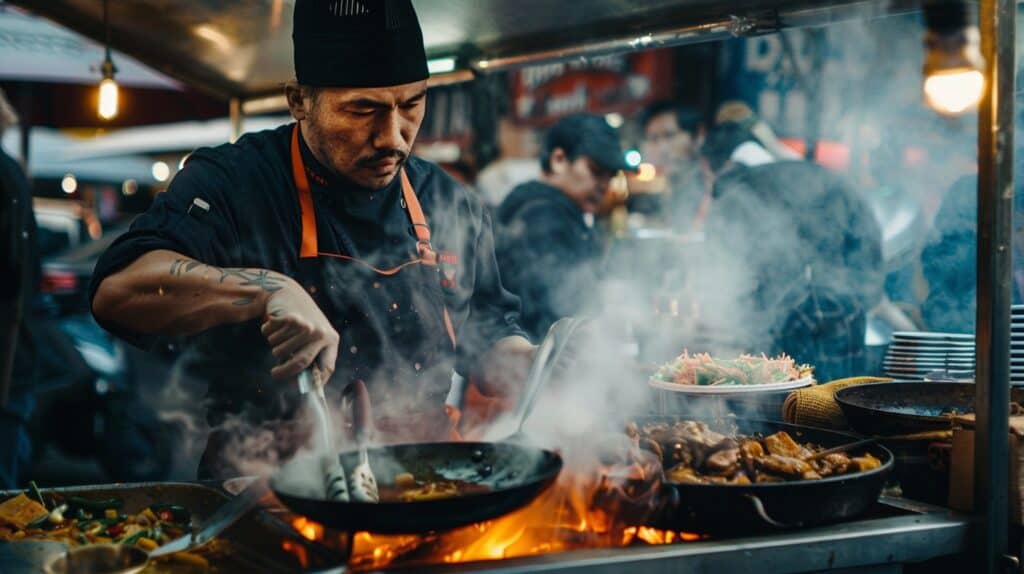Dreaming of starting your own restaurant but find your wallet saying otherwise? You’re not alone. It turns out, launching a dining spot with little to no cash is more doable than you might think.
This guide will dish out slick strategies to get the ball rolling on empty pockets—and yes, folks have pulled it off before. Get ready for some tasty insights!
Key Takeaways
Starting a restaurant with minimal funds is achievable through food trucks, ghost kitchens, or home-based catering to cut startup costs.
Crafting an effective business plan and devising a solid marketing strategy are crucial steps in attracting customers and managing finances efficiently.
Exploring unique funding options like grants, loans from non – bank lenders, private investors, and crowdfunding can provide the necessary capital without traditional bank hurdles.
Acquiring essential licenses and permits ensures the legal operation of the restaurant, while assembling a qualified staff contributes significantly to the business’s success.
Alternative methods such as partnering with restaurant service providers or starting in an incubator offer support, mentorship, and sometimes funding opportunities for new restaurateurs.
Table of Contents
Understanding the Basics of Starting a Restaurant

Kicking off a restaurant with zilch in the bank might sound like a plot from a feel-good movie, but hey, it’s doable if you get a factoring company to help. The secret sauce? Embracing low-budget startup ideas such as food trucks, ghost kitchens, and home-based catering businesses.
These aren’t just cost-effective; they’re your entry ticket to the food service universe without selling an arm and leg.
Crafting a killer business plan is your next move. This isn’t about jotting down some wild dreams on a napkin—oh no. You need to lay out everything, from what you’ll serve to how you’ll scream it from the digital rooftops (hello social media!).
And let’s not forget diving into those spreadsheets for budget tracking and financial forecasts. Think of your business plan as the map that keeps you from getting lost in the wild world of restaurateuring—and trust us, it’s easy to get turned around!
Low-Cost Restaurant Startup Ideas

Think starting a restaurant needs a pot of gold? Think again. Dive into these wallet-friendly startup ideas that flip the script on big spending… and they’re just as savory.
Launching a Food Truck
Kicking off a food truck venture is the smart move for those scared to dive deep into their pockets. Costs range significantly, from $40,000 to $250,000—still less daunting than opening a sit-down restaurant.
Opting for a used vehicle and preloved equipment can trim down this initial outlay even more. Key to success? Parking where the hungry crowds are. Think bustling streets, festivals, or near buzzing office parks.
Financing could come through various channels; grants catch your eye with no payback strings attached. Business and SBA loans offer structured repayment but require good credit scores and sometimes collateral.
Private investors bring in cash plus invaluable experience, though they’ll want a slice of your pie. Crowdfunding platforms like Kickstarter give everyone a chance to back their favorite taco truck dream while spreading the word—killing two birds with one stone, you might say.
And let’s not forget team assembly—finding that chef who can turn heads with just the scent of their dishes or servers who charm the socks off customers is golden.
Establishing a Ghost Kitchen or Ghost Restaurant
Starting a ghost kitchen or ghost restaurant is a smart move for those tight on cash. It’s all about cooking up tasty food in a rented commercial space and then delivering it straight to customers’ doors.
You don’t need a fancy dining area or lots of staff, which keeps the startup costs down — think in the range of $10,000 to $50,000. This setup relies heavily on online ordering and delivery apps like Uber Eats.
Picking the right spot for your ghost kitchen plays a big role too. Look for places with good foot traffic but less competition. Remember, even though your customers won’t walk through your door, drivers find you easily is key! With lower expenses and the power of digital marketing tools at your fingertips, making money from your love of cooking just got real possible.
Next up: Starting a Home-Based Catering Business…
Starting a Home-Based Catering Business
Moving from the concept of ghost kitchens, let’s shift gears towards rolling out your culinary dreams right from home. Kicking off a catering business at home slashes those daunting startup costs and throws you into the deep end—testing if your restaurant vision floats or sinks.
It’s like getting a taste of the big leagues without betting all your scared money on one spin.
You’ll need to squeeze every drop of creativity from that chef’s hat. Imagine transforming your kitchen into a bustling hub for mouth-watering dishes. You’re not just making meals; you’re crafting experiences, one event at a time.
And here’s the kicker—with some hustle and smart marketing strategies, turning beer money into a steady flow isn’t just possible; it’s on the menu. So fire up that stove and start spreading the word because this could be where it all begins…
Creating a Comprehensive Business Plan

Crafting a solid business plan is like drawing your treasure map – it guides you through every step, ensuring you don’t miss the mark on making your restaurant dream a reality… Keep reading to learn how this blueprint can set your eatery up for success!
Devise a Marketing Strategy
Creating a solid marketing plan is like laying down the tracks for your restaurant’s success train. Start by identifying who would love your food and service. That’s your target audience.
Next, mix up your approach—use social media, email newsletters, and community events to spread the word. Think of it as creating a buzz that even bees can’t ignore.
Get creative with promotions and deals to lure customers in. Once they’ve had a taste, keep them coming back with loyalty programs or surprise discounts. Engage with them online, too; respond to reviews and share behind-the-scenes glimpses on platforms where your future regulars hang out—be it Instagram stories or LinkedIn posts for those corporate lunches.
It’s all about making connections that count…and keep the cash register ringing!
Choosing the Ideal Location

Picking the perfect spot for your restaurant is like finding a treasure chest in the world of business. It’s all about location, location, location! You want a place with lots of foot traffic and easy to get to.
Think about parking too; no one likes to circle the block ten times. Your restaurant should be visible – a beacon for hungry folks.
Consider what’s around you as well. Too many competitors? That could spell trouble. But if you’re offering something fresh and different, being in a busy area might just work in your favor.
Make sure the vibe of your neighborhood matches the essence of your menu – whether it’s fast food or fine-dining you’re serving up, aligning these elements is key. And don’t overlook history – every building tells a story that can add flavor to your restaurant’s charm!
Crafting an Appealing Menu

Your menu is your first handshake with the customer. You want it strong, confident, and memorable. Think of it as a map to your culinary world. It should guide folks through flavors and stories you’re eager to share.
Highlight dishes that scream “you.” Maybe it’s smoked ribs that fall off the bone or vegan tacos packed with flavor. Your goal? Get them drooling before they even sit down.
Now, balance is key – offer enough variety to cater to different tastes but don’t overdo it. Too many choices can overwhelm everyone involved, from your chefs to the diners themselves.
Keep descriptions clear but enticing; think “juicy, herb-crusted chicken” over just “grilled chicken.” And remember–pricing matters! Aim for sweet spots that make both wallets and taste buds happy.
Let’s shift gears and look at what comes next: Preparing for Potential Restaurant Costs…
Preparing for Potential Restaurant Costs

Kicking off a restaurant isn’t just about the tasty dishes — it’s also about counting those pennies and dimes. You’ll need to have a clear view of what you’re diving into, from sprucing up the place to getting the right spoons and spatulas.
Remodeling or Restaurant Improvements
Sprucing up your space is key to drawing in customers. You want a vibe that shouts, “Come on in!” Talk to your landlord about restaurant buildout options. They might cut you a deal or throw in some tenant improvement allowance.
It’s like finding hidden treasure, but instead of gold coins, it’s extra cash for making your place shine.
Keep things fresh without breaking the bank. Small touches can make a big difference. Think new paint, funky art, or even just rearranging the furniture for better flow. It shows you care about the details and keeps regulars intrigued—and coming back to see what’s new.
Plus, it tells first-timers you’re on top of your game… and that’s exactly where you want to be.
Restaurant Equipment
Once your space looks the part, it’s time to gear up. The right equipment in your kitchen isn’t just about cooking; it’s about staying ahead in the fast-paced food game. Let’s talk stoves, fridges, and ovens—the big guns of the culinary world.
These aren’t just pieces of metal but the heartbeats of your restaurant. You want them efficient and reliable because when the dinner rush hits, there’s no room for error.
And don’t forget about those smaller heroes: blenders for smoothies or soups, coffee makers that keep the morning crowd happy, and toasters that add just the perfect crunch to breakfast orders.
Each piece is a cog in a well-oiled machine aiming to pump out plate after plate of deliciousness. You’ll need cutting-edge point-of-sale systems too—they keep tabs on orders and payments like a boss so you can focus on what you do best: feeding souls one meal at a time.
Restaurant Furniture, Supplies, and Technology
Shop for restaurant booths and kickstart your dining space with style. You need tables, chairs, and maybe some snazzy bar stools that won’t break the bank but will still scream “Come in!” to anyone walking by.
Think about it – a comfy booth can turn a quick bite into an experience customers want to repeat. Plus, having the right furniture sets the tone for your entire place.
Now, let’s talk tech because you can’t ignore it. Point of sale systems make life easier, not just for you, but for your customers too. And don’t forget about kitchen gadgets! A high-speed oven or an efficient food processor can do wonders, speeding up service and keeping those plates coming.
Remember to keep a careful eye on prices—you’re here to make money, after all. The goal? Equip your space without emptying your pockets completely.
Unique Funding Strategies for Your Restaurant

Thinking outside the box could open up a world of financial opportunities for your restaurant dream. From crowdfunding magic to sweet-talking angel investors, there’s always a creative way to fuel your foodie venture…
Securing Grants
Securing grants is like hitting a home run in the restaurant game. You need to keep an eye out for opportunities and swing hard when they come your way. Start by digging deep into research.
Explore every nook and cranny where funding might hide. Think local government initiatives, food industry associations, and non-profits keen on boosting small businesses. They often have pots of gold earmarked for folks just like you aiming to stir the pot in the food scene.
With grant money, you’re not just opening doors; you’re knocking down walls without owing a dime back! Sounds dreamy, right? To get there, craft compelling stories around your restaurant vision.
Show how it spices up the community or fills a gaping void in the local dining landscape. Remember, securing these funds means standing out in a sea of applicants—so let your passion simmer through every word of that application.
Next up: diving into obtaining business loans…
Obtaining a Business Loan
To get a business loan, you’ll need to impress the banks. Start by polishing up that credit score—aim for 680 or higher. Banks and lenders love seeing those numbers. They’re also keen on a low debt-to-credit ratio.
It shows you’re not just throwing money around like confetti at a parade.
Thinking outside the box can pay off too. Non-bank lenders, like BlueVine and OnDeck, offer alternative routes to funding without the traditional hurdles. They might be your ticket in if the big banks give you the cold shoulder.
Next up, let’s talk about partnering with private investors…
Partnering with Private Investors
Beyond loans, tapping into private investors is a smart move. These folks have the dough and are looking to place it in promising ventures. They’re not just throwing money around; they seek potential in your restaurant dream.
This route can fill your startup coffers without the burden of hefty interest rates that come with bank loans.
Getting a nod from an angel investment network or venture capital firms hinges on more than just passion. You’ve got to show them numbers – real proof that your restaurant will turn their investment into more cash down the line.
Think of this as joining forces with someone who’s got both the financial muscle and, possibly, valuable insight into making your eatery a hit in town.
Exploring Crowdfunding
After considering private investors, crowdfunding emerges as a dynamic option. Platforms like GoFundMe and Kickstarter can open doors for your restaurant dream without upfront cash.
It’s all about painting a vivid picture of your concept to potential backers online. Think cupcakes, dog murals, and exclusive invites to your grand opening – these rewards can entice folks to open their wallets.
Crowdfunding isn’t just about raising funds; it’s building a community around your restaurant before the doors even open. Use compelling stories and clear goals on sites like Indiegogo to connect with supporters globally.
Every pledge brings you one step closer to flipping that “Open” sign in the window of your very own place.
Acquiring Necessary Restaurant Licenses and Permits

Jumping through hoops to get the right restaurant licenses and permits might seem like a circus act, but it’s all part of the show in staying legal. You’ve got to check off health department certifications, food service licenses, and maybe even a liquor license if you’re planning on serving cold ones.
Each city plays by its own rules, so local government offices are your go-to for what’s needed. Think of it as your backstage pass – without it, there’s no show.
Getting this paperwork sorted isn’t just ticking boxes; it lays down the law for running a safe and sound spot where folks love to eat. From fire codes to building health standards, these permits ensure your kitchen is more than just a place that smells amazing – it’s safe for everyone who walks through those doors.
And hey, with every form filled and fee paid, you’re one step closer to flipping those “Closed” signs to “Open”, inviting hungry customers into your very own slice of culinary heaven.
Assembling a Qualified Staff

Finding the right crew is like picking a winning team. You need people who can handle the heat in the kitchen and still serve smiles. Let’s talk about finding your MVPs – from chefs to servers, each role is key.
You want a general manager who’s got an eagle eye for detail and can rally the troops. A bartender who knows their way around jellies, pickles, and everything in between ensures your drink menu pops as much as your food.
Hiring doesn’t stop with skills; attitude plays a big part too. Seek out employees with grit – those ready to grind during rush hours and crack jokes when the dust settles. Think of it this way – every great meal needs top-notch ingredients, just like your restaurant needs top-tier staff to stay in business.
From dishwashers to food runners, everyone’s contribution flavors the customer experience. So take your time, find folks who share your vision and zest for creating unforgettable dining moments.
Starting a Restaurant with Alternative Methods

Diving into alternative ways to start a restaurant might just be the game-changer you’re looking for—think outside the traditional box and see where creativity takes you… Keep reading, and let’s stir up some excitement!
Becoming a Partner of a Restaurant Service Provider
Teaming up with a restaurant service provider opens doors you didn’t even know were there. Think of it as hitching your wagon to a star that’s already shooting across the sky. These partnerships offer support, mentorship, and sometimes even funding.
Look at Chobani Incubator or Toast Capital—they’re like guardian angels for food startups. They give you the cash flow bump without the headache of compounding interest.
This route lets you focus on what you do best—creating mouthwatering dishes—while leaving some of the heavy lifting to those who’ve been down this road before. It’s like having a backstage pass in the food industry; access all areas, learning from those who know how to avoid the potholes.
Plus, joining forces can boost your credibility and customer base right off the bat. Talk about getting a leg up!
Starting in a Restaurant Incubator
Jumping into a restaurant incubator could be your golden ticket. These places are like boot camps for future restaurateurs. They provide kitchen space, essential tools, and even some cash to get the ball rolling—all without demanding a slice of your business in return.
Plus, they throw in marketing support and business coaching on the house. Think of it as having a wise mentor who not only shows you the ropes but also hands you the tools and cheers from the sidelines.
Now imagine walking into an arena filled with folks just like you – eager, ambitious, ready to cook up a storm. That’s what an incubator feels like. Networking opportunities? You bet.
You’ll meet people who’ve been exactly where you are now, alongside those still figuring it out. Every handshake has the potential to open new doors or spark fresh ideas—the kind that could take your food dreams from scribbles on napkins to hot plates on tables.
Considering Starting with a Pop-Up, Food Truck, or Catering Business
Kicking off with a pop-up, food truck, or catering business is a savvy move. It’s like dipping your toes in the water without diving headfirst. Think about it—low costs, high flexibility.
You get to test drive your restaurant idea without signing a lease that’ll eat into your savings. Pop-ups let you pop anywhere, from street corners to festivals, and show off what you’ve got cooking.
Plus, they’re all the rage.
Food trucks crank up the heat by bringing your kitchen on wheels right to the hungry crowd. They’re perfect for slinging tacos, burgers, or whatever else gets mouths watering—and they keep startup costs lower than traditional restaurants.
Then there’s home-based catering —the ultimate side hustle for those who can make a mean meal but aren’t ready to commit full-time yet. Cater events small and large, and watch as word of mouth makes your phone buzz with orders.
Each option offers its own flavor of freedom and potential profit without chaining you down financially or physically from day one.
FAQs About How to Start a Restaurant with No Money
How can I start a restaurant when my wallet’s on a diet?
Ah, the age-old dream of starting a restaurant with pockets as empty as your stomach before breakfast… But fear not! With strategies like crowdfunding campaigns and peer-to-peer lending, you’re looking at turning those dreams into reality without breaking the bank. Think of it like inviting friends to pitch in for pizza—everyone chips in, and boom, you’ve got yourself a slice of the pie.
What’s this buzz about pop-up restaurants and cloud kitchens?
Imagine throwing a dinner party without worrying about cleaning your house—that’s pretty much the gist with pop-up restaurants and cloud kitchens. These babies let you serve up your signature dishes without the hefty price tag of owning physical space. It’s like being a culinary ninja; show up, wow them with your cooking skills, vanish before anyone knows what hit them.
Can’t cook? No problem! How do side hustles fit into this?
So, you can’t tell a spatula from a spoon? No worries! Side hustles are here to save the day. You could sell anything from granola to hot sauce or even baked goods right from your kitchen while building up that startup capital. It’s all about using what you’ve got to get where you’re going—like turning lemons into lemonade (or, in this case, money).
Is there any magic spell for getting financial support without selling my soul?
No need for crossroads deals or magic spells here—financial support might be closer than you think! From small business loans courtesy of Uncle Sam (a.k.a., U.S. Small Business Administration) to convincing an angel investor (business angels—not the winged ones) that your idea is worth their dime… There are more ways to raise funds than there are fish in the sea.
Waiters and menus and stock – oh my! How do I manage all these moving parts?
It’s like juggling flaming torches while riding a unicycle—but way cooler because it’s food-related. Start simple: focus on crowd-pleasers for your menu items and keep an eye on labor costs by hiring only essential staff at first (sorry cousin Joe). Equipment rental over buying will also keep those pennies pinned down tightly in your pocket!
What if I’m as popular as leftover lunch? How do I draw customers in?
Fear not—you won’t be dining alone forever! Hitting the ground running with some spicy outbound marketing tactics will have people lining up faster than kids at an ice cream truck on a hot day. Get creative: social media buzz, mouth-watering flyers, or even partnering with local businesses can turn heads—and stomachs—in no time flat.




